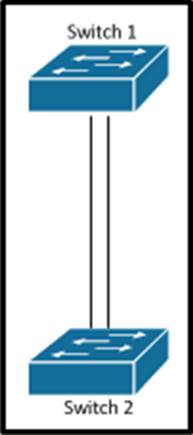Which set of configurations will result in all ports on both switches successfully bundling into an EtherChannel?
Refer to the exhibit.

Which set of configurations will result in all ports on both switches successfully bundling into an EtherChannel?
A . switch1 channel-group 1 mode active switch2 channel-group 1 mode auto
B . switch1 channel-group 1 mode desirable switch2 channel-group 1 mode passive
C . switch1 channel-group 1 mode on switch2 channel-group 1 mode auto
D . switch1 channel-group 1 mode desirable switch2 channel-group 1 mode auto
Answer: D
Explanation:
The different etherchannel modes are described in the table below: Mode Description
active Places an interface into an active negotiating state, in which the interface starts negotiations with other interfaces by sending LACP packets.
auto Places an interface into a passive negotiating state, in which the interface re- sponds to PAgP packets it receives but does not start PAgP packet negotia- tion. This setting minimizes the transmission of PAgP packets.
desirable Places an interface into an active negotiating state, in which the interface starts negotiations with other interfaces by sending PAgP packets.
on Forces the interface into an EtherChannel without PAgP or LACP. With the on mode, a usable EtherChannel exists only when an interface group in the on mode is connected to another interface group in the on mode.
passive Places an interface into a passive negotiating state, in which the interface re- sponds to LACP packets that it receives, but does not start LACP packet ne-gotiation. This setting minimizes the transmission of LACP packets.
Both the auto and desirable PAgP modes allow interfaces to negotiate with partner interfaces to determine if they can form an EtherChannel based on criteria such as interface speed and, for Layer 2 EtherChannels, trunking state and VLAN numbers. Interfaces can form an EtherChannel when they are in different PAgP modes as long as the modes are compatible. For example:
An interface in the desirable mode can form an EtherChannel with another interface that is in the desirable or auto mode.
An interface in the auto mode can form an EtherChannel with another interface in the desirable mode. An interface in the auto mode cannot form an EtherChannel with another interface that is also in the auto mode because neither interface starts PAgP negotiation. An interface in the on mode that is added to a port channel is forced to have the same characteristics as the already existing on mode interfaces in the channel.
Reference: http://www.cisco.com/c/en/us/td/docs/switches/lan/catalyst3550/software/release/121_13_ea1/configuration/guide/3550scg/swethchl.html
Latest 300-115 Dumps Valid Version with 342 Q&As
Latest And Valid Q&A | Instant Download | Once Fail, Full Refund

